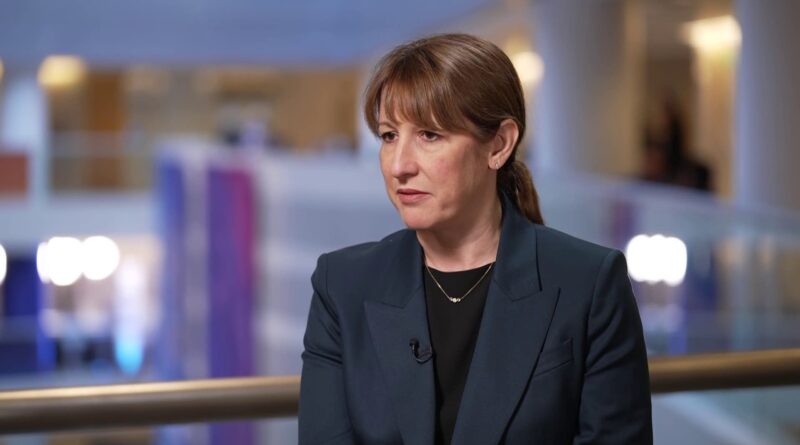UK rate cut hangs in the balance after latest inflation data
People walk past independent retailers on the Old High Street in Folkestone, UK, on Friday, Oct. 17, 2025. Inflation has surged on food and energy costs this year, with figures forecast to show it hitting 4% in September double the 2% target.
Bloomberg | Bloomberg | Getty Images
Another interest rate cut from the Bank of England this year looks uncertain after the latest U.K. inflation data came in cooler expected.
The annual inflation rate was unchanged in September, coming in at 3.8% for the third month in a row.
The data, released by the Office for National Statistics (ONS) Wednesday, shows that the financial squeeze on consumers and businesses remains high, but there are hopes this could be the peak.
The Bank of England forecast earlier this year that the consumer price index would top out at 4% — double the central bank’s target — in September, before gradually cooling into next year. Economists polled by Reuters had also expected the rate to rise to 4% in the twelve months to September.
September’s core inflation, which excludes more volatile energy, food, alcohol and tobacco prices, rose by an annual 3.5% in the year to September, down from 3.6% in August.
“The largest upward drivers came from petrol prices and airfares, where the fall in prices eased in comparison to last year. These were offset by lower prices for a range of recreational and cultural purchases including live events,” Grant Fitzner, chief economist at the ONS, commented Wednesday.
“The cost of food and non-alcoholic drinks also fell for the first time since May last year,” he added.
Chancellor Rachel Reeves said she was “not satisfied” with the inflation numbers and noted in a statement that “all of us in government are responsible for supporting the Bank of England (BOE) in bringing inflation down.”
November rate cut unlikely?
The data is the last inflation reading before the BOE’s next meeting on Nov. 6.
Some economists believe the central bank could trim its benchmark interest rate from the current level of 4% given lower-than-expected inflation data and lackluster growth figures. Others think the central bank could maintain its cautious stance, given that inflation remains sticky and the economic picture is mixed.
The latest GDP data showed the British economy expanded by just 0.1% month-on-month in August.
George Brown, senior economist at Schroders, noted Wednesday that the latest inflation data could lead investors to reconsider expectations for a trim next month.
“Inflation near 4% should serve as a wake-up call for markets, which continue to price in two more rate cuts next year, ” George Brown, senior economist at Schroders, noted Wednesday. The bank will hold its last meeting of the year on Dec. 18.
“High inflation is at risk of becoming entrenched in the U.K., due to a combination of disappointing productivity and sticky wage growth. We expect the Bank of England will keep interest rates on hold until the end of 2026 and we wouldn’t rule out its next rate move being upward,” Brown said.
Suren Thiru, ICAEW economics director, agreed that “despite softer than expected inflation, the chances of a November rate cut are hanging by a thread, particularly as rate-setters will likely want to analyse the inflationary impact of any measures announced in the Budget before relaxing policy again,” he said in emailed comments.
The BOE’s Monetary Policy Committee (MPC) will certainly be cautious about meddling with interest rates ahead of the government’s Autumn Budget on Nov. 26, in which Finance Minister Rachel Reeves could announce tax rises as well as spending cuts, which could be disinflationary.

Difficult decisions for Reeves, and the BOE
“A mixed economic picture has emerged for the U.K. over recent months which is setting the tone for difficult decisions in the upcoming Budget,” according to Scott Gardner, investment strategist at J.P. Morgan owned digital wealth manager, Nutmeg.
“It isn’t just the Chancellor who has little room for manoeuvre with the Bank of England also having few levers to pull as the economy experiences a period of elevated inflation and low growth,” he said in emailed comments Wednesday.
“It looks increasingly unlikely that we will see a fourth and final rate cut this year, despite this latest reading undershooting expectations, unless the labour market significantly weakens,” he added.
British Chancellor of the Exchequer Rachel Reeves speaks to media prior to her speech on day two of the Labour Party conference at ACC Liverpool on September 29, 2025 in Liverpool, England.
Ian Forsyth | Getty Images News | Getty Images
Matthew Ryan, head of market strategy at global financial services firm Ebury, said the BOE’s MPC “is stuck between a rock and a hard place.”
“The cooling in Britain’s jobs market is screaming out for further reductions in the base rate, but high inflation warrants a need for caution. We think that most officials will probably need to see more evidence that inflation has indeed peaked, but today’s data does at least mark a step in the right direction,” he said in emailed comments.
“We are not holding our breath for a November cut, which we see as essentially off the table. Markets now view a December cut as more likely than not, but we are still not entirely convinced just yet, and believe that elevated inflation could thwart any further easing until at least February,” he added.
Source – Middle east monitor




